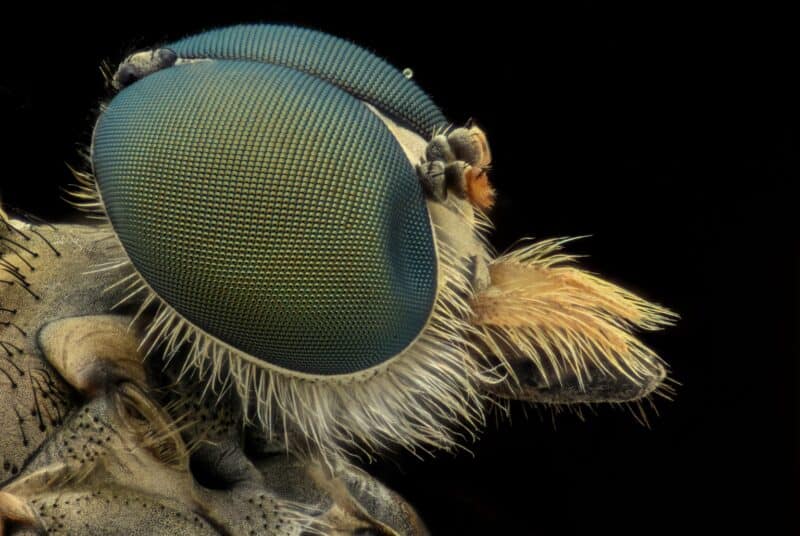Ask anybody who is unsettled by insects what bothers them the most, and at least some of them are going to answer that it is their creepy eyes.

Most insects have eyes that are beady, lifeless-looking, strange, or just too big. It’s enough to give you the willies! But how about our bee friends? How many eyes does a bee have?
Bees actually have five eyes: three small simple eyes up near the top of their head, and two larger compound eyes that wrap around either side.
Interesting stuff! Most folks, including me for a long time, thought that bees just had two big compound eyes.
Usually when we’re talking about tiny critters it is spiders that have too many eyes, but bees have a few extras too, it seems!
Anyway, the physiology and vision of bees is actually quite fascinating, so keep reading and I’ll tell you all about it…
Bees Have Two Different Kinds of Eyes for Different Functions
As I mentioned above, bees have two different and distinct types of eyes. They have three smaller ones set near the top of their head that are called simple eyes, and the larger, oblong compound eyes that wrap around the side of their head.
This certainly gives bees a good field of view, but each of the eyes has a distinct purpose, and they work together in harmony to keep a bee informed of its environment, to help it do its job for the hive and also to alert the bee to threats.
Bees Use Their Simple Eyes for Direction Finding and Sensing Light Levels
The three smaller simple eyes of the bee, sometimes called the ocelli eyes, rest near the top or front of a bee’s face in a triangle arrangement.
These eyes have a specific job concerning the detection and discernment of light intensity, and they are also unique because they’re capable of detecting even subtle changes in the intensity of light.
Bees need their simple eyes in order to detect the presents and the location of the sun, and they depend on this position to help them find their way back to their hive.
Used this way, the simple eyes are a critical part of a bee’s navigational ability. They also help bees detect shadows which can indicate the presence of obstacles or threats.
The Larger Compound Eyes are for Details and Pattern Recognition
The compound eyes of the bee are the ones on either side of the head, wrapping around to the top and bottom in a sort of kidney bean shape.
These are the eyes that most of us are familiar with because they are the ones that are easy to see on the bee’s head.
The compound eyes have many functions, as they are the ones that detect specific patterns, colors and the presence of polarized light.
Together, these are the ones that a bee relies on to find various flowers and other beneficial plants out in the world.
The compound eyes also sprout tiny, incredibly fine hairs, and though their precise function is unknown even to this very day.
It is thought that they help to keep the eyes clean by snagging stray pollen granules and other debris for later, easy cleaning when the bee is grooming itself.
There’s also some speculation that these tiny hairs act as sort of airspeed or wind direction indicators, and so play another vital role in helping a bee navigate.
A Bee’s Compound Eye Has Thousands of Individual Facets
Most of us probably remember from our grade school science class that compound eyes are called such because they are not a singular receptor like our own eyes.
Instead, a compound eye is made up of many incredibly tiny, individual sensors that function like little eyes themselves, and these tiny parts are known as facets.
Each compound eye that a bee has is made up of many thousands of facets, specifically 6,900 in most species.
Basically, each facet will take its own tiny image and then transmit it to the brain where it’s assembled into a whole image, sort of like a mosaic picture.
Also, it is thought that the compound eyes further help in navigation by allowing the bee to sort of make calculations by comparing the subtle offset in the images that its eyes capture.
This in conjunction with the position of the sun and the presence of polarized light uses this to navigate over proportionally great distances away from its hive – almost 4 miles!- and find its way to and from a food source and back with pinpoint accuracy.
Bee Eyes are Highly Attuned to Motion
Both sets of a bee’s eyes are also highly adapted to motion. In fact, a bee has incredible reflexes compared to most mammals and humans particularly.
A bee’s visual recognition system is capable of discerning even the subtlest movement in its field of vision, interpreting it and then reacting and as little as a 300th of a second.
That’s some truly hair-trigger reaction time! But when you are as tiny as a bee is and there are plenty of things in the world that can hurt you or actually want to eat you, it pays to be quick.
Tom has lived and worked on farms and homesteads from the Carolinas to Kentucky and beyond. He is passionate about helping people prepare for tough times by embracing lifestyles of self-sufficiency.
